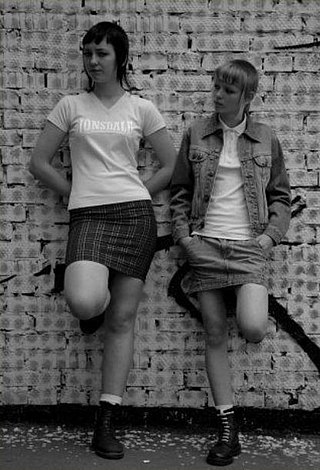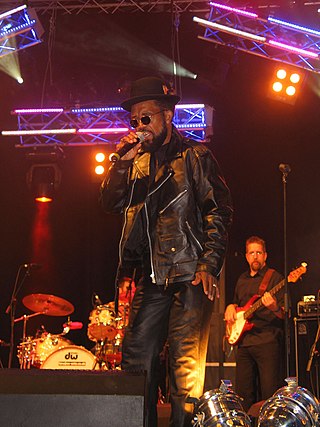
Postmodernism is a term used to refer to a variety of artistic, cultural, and philosophical movements that claim to mark a break from modernism. They have in common the conviction that it is no longer possible to rely upon previous ways of depicting the world. Still, there is disagreement among experts about its more precise meaning even within narrow contexts.

A skinhead or skin is a member of a subculture that originated among working-class youth in London, England, in the 1960s. It soon spread to other parts of the United Kingdom, with a second working-class skinhead movement emerging worldwide in the late 1970s. Motivated by social alienation and working-class solidarity, skinheads are defined by their close-cropped or shaven heads and working-class clothing such as Dr. Martens and steel toe work boots, braces, high rise and varying length straight-leg jeans, and button-down collar shirts, usually slim fitting in check or plain. The movement reached a peak at the end of the 1960s, experienced a revival in the 1980s, and, since then, has endured in multiple contexts worldwide.

A subculture is a group of people within a cultural society that differentiates itself from the values of the conservative, standard or dominant culture to which it belongs, often maintaining some of its founding principles. Subcultures develop their own norms and values regarding cultural, political, and sexual matters. Subcultures are part of society while keeping their specific characteristics intact. Examples of subcultures include BDSM, hippies, hipsters, goths, steampunks, bikers, punks, skinheads, gopnik, hip-hoppers, metalheads, cosplayers, otaku, otherkin, furries, hackers and more. The concept of subcultures was developed in sociology and cultural studies. Subcultures differ from countercultures.

Chicano rock, also called chicano fusion, is rock music performed by Mexican American (Chicano) groups or music with themes derived from Chicano culture. Chicano Rock, to a great extent, does not refer to any single style or approach. Some of these groups do not sing in Spanish at all, or use many specific Latin instruments or sounds. The subgenre is defined by the ethnicity of its performers, and as a result covers a wide range of approaches.

Rude boy is a subculture that originated from 1960s Jamaican street culture. In the late 1970s, there was a revival in England of the terms rude boy and rude girl, among other variations like rudeboy and rudebwoy, being used to describe fans of two-tone and ska. This revival of the subculture and term was partially the result of Jamaican immigration to the UK and the so-called "Windrush" generation. The use of these terms moved into the more contemporary ska punk movement as well. In the UK and especially Jamaica, the terms rude boy and rude girl are used in a way similar to gangsta, yardie, or badman.

Mod, from the word modernist, is a subculture that began in late 1950s London and spread throughout Great Britain, eventually influencing fashions and trends in other countries. It continues today on a smaller scale. Focused on music and fashion, the subculture has its roots in a small group of stylish London-based young men and women in the late 1950s who were termed modernists because they listened to modern jazz. Elements of the mod subculture include fashion ; music and motor scooters. In the mid-1960s when they started to fade out, the subculture listened to rock groups with jazz and blues influences such as the Who and Small Faces. The original mod scene was associated with amphetamine-fuelled all-night jazz dancing at clubs.

In the arts, bricolage is the construction or creation of a work from a diverse range of things that happen to be available, or a work constructed using mixed media.

In criminology, subcultural theory emerged from the work of the Chicago School on gangs and developed through the symbolic interactionism school into a set of theories arguing that certain groups or subcultures in society have values and attitudes that are conducive to crime and violence. The primary focus is on juvenile delinquency because theorists believe that if this pattern of offending can be understood and controlled, it will break the transition from teenage offender into habitual criminal. Some of the theories are functionalist, assuming that criminal activity is motivated by economic needs, while others posit a social class rationale for deviance.

Youth subculture is a youth-based subculture with distinct styles, behaviors, and interests. Youth subcultures offer participants an identity outside of that ascribed by social institutions such as family, work, home and school. Youth subcultures that show a systematic hostility to the dominant culture are sometimes described as countercultures.
Sarah L. Thornton is a writer, ethnographer and sociologist of culture. Thornton has authored four books and many articles about artists, the art market, bodies, people, culture, technology and design, the history of music technology, dance clubs, raves, cultural hierarchies, subcultures, and ethnographic research methods.
Alternative fashion or alt fashion is fashion that stands apart from mainstream, commercial fashion. It includes both styles which do not conform to the mainstream fashion of their time and the styles of specific subcultures. Some alternative fashion styles are attention-grabbing and more artistic than practical, while some develop from anti-fashion sentiments that focus on simplicity and utilitarianism.
Georgina Emma Mary Born, is a British academic, anthropologist, musicologist and musician. As a musician she is known as Georgie Born and for her work in Henry Cow and with Lindsay Cooper.

Angela McRobbie is a British cultural theorist, feminist, and commentator whose work combines the study of popular culture, contemporary media practices and feminism through conceptions of a third-person reflexive gaze. She is a professor of communications at Goldsmiths College, University of London.
Criticism of postmodernism is intellectually diverse, reflecting various critical attitudes toward postmodernity, postmodern philosophy, postmodern art, and postmodern architecture. Postmodernism is generally defined by an attitude of skepticism, irony, or rejection towards what it describes as the grand narratives and ideologies associated with modernism, especially those associated with Enlightenment rationality. Thus, while common targets of postmodern criticism include universalist ideas of objective reality, morality, truth, human nature, reason, science, language, and social progress, critics of postmodernism often defend such concepts.
Isla Vista Arts is an organization at the University of California, Santa Barbara with the goal of promoting art and culture in the small, neighboring community of Isla Vista, California. It is affiliated with the UCSB Interdisciplinary Humanities Center and Associated Students. Isla Vista Arts provides free and low-cost entertainment to college students and community members.
Subculture: The Meaning of Style is a 1979 book by Dick Hebdige, focusing on Britain's postwar youth subculture styles as symbolic forms of resistance. Drawing from Marxist theorists, literary critics, French structuralists, and American sociologists, Hebdige presents a model for analyzing youth subcultures. While Hebdige argues that each subculture undergoes the same trajectory, he outlines the individual style differences of specific subcultures, such as Teddy boys, mods, rockers, skinheads, and punks. Hebdige emphasizes the historical, class, race, and socioeconomic conditions that surrounded the formation of each subculture. While Subculture: The Meaning of Style is one of the most influential books on the theory of subcultures, it faces a range of critiques.

Mark Fisher, also known under his blogging alias k-punk, was an English writer, music critic, political and cultural theorist, philosopher, and teacher based in the Department of Visual Cultures at Goldsmiths, University of London. He initially achieved acclaim for his blogging as k-punk in the early 2000s, and was known for his writing on radical politics, music, and popular culture.
Kim Teru Yasuda is an American artist known for her sculptures, site-specific installations and public art projects exploring themes of memory, identity, and social engagement in public spaces.
Matthew Worley is a British academic and author. He is Professor of Modern History at the University of Reading.










